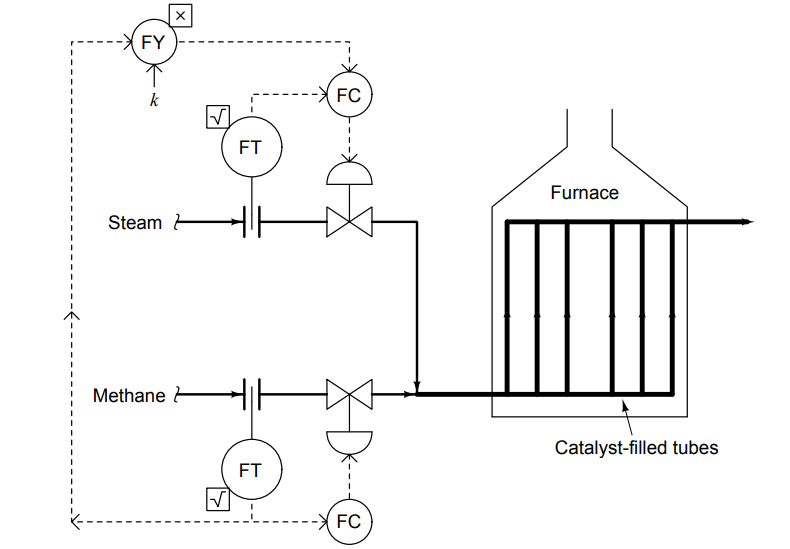Reforming furnaces are special process furnaces used to generate pure hydrogen gas from a hydrocarbon feed gas, such as methane.
The balanced chemical reaction for this process is as follows:
CH4 + H2O → 3H2 + CO
Methane gas (CH4) added to steam (H2O) at high temperatures forms hydrogen gas (H2) and carbon monoxide gas (CO), the latter converted into CO2 and more hydrogen gas in subsequent reactions. The chemical reaction is endothermic, meaning that it requires energy input rather than liberating energy (as what happens in an exothermic process such as combustion).
Typically, the reaction takes place in the presence of a catalyst. A simplified control system for a reforming furnace is shown here:

1. What factor or factors determine the setting of the multiplying constant k? Is this factor something that is liable to change much? Why or why not?
Answer: Stoichiometry is the primary determining factor for the value of k: setting the methane and steam mass flow rates such that the proper numbers of molecules of each enter the reaction furnace to produce hydrogen and carbon monoxide gas.
2. Explain what would happen in this process if the methane flow transmitter failed with a low signal.
3. Explain what would happen in this process if the methane flow transmitter failed with a high signal.
4. Explain what would happen in this process if the steam flow transmitter failed with a low signal.
5. Explain what would happen in this process if the steam flow transmitter failed with a high signal.
6. Explain what would happen in this process if the methane control valve failed fully shut.
7. Explain what would happen in this process if the methane control valve failed wide-open.
8. Explain what would happen in this process if the steam control valve failed fully shut.
9. Explain what would happen in this process if the steam control valve failed wide-open.
10. Explain what would happen in this process if some of the catalyst-filled tubes were to become partially plugged with carbon (coke) deposits.
Join the Discussion! Share your answers with us through below comments section.
The PLC panel and MCC panel interface signals are start, stop, run feedback, trip, local…
In this article, we are going to discuss about shutter door control using induction motor…
Electrical Drives control the motion of electric motors. Motion control is required in industrial and…
PLC ladder logic design to control 3 motors with toggle switch and explain the program…
VFD simulator download: Master the online tool from the Yaskawa V1000 & programming software for…
The conveyor sorting machine is widely used in the packing industries using the PLC program…